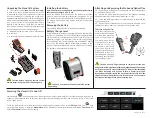
Disk Buffers Menu 4-179
SR785 Dynamic Signal Analyzer
To read this file into a trace, a 400 line FFT must first be stored in the trace. This can be
done using <Display to Trace> or <Disk to Trace>. Loading the ASCII file into the trace
then replaces the trace data with the data from the disk file.
Command: TASC ? i, n
Load Trace Data (binary)
Load binary data from the Current File in the Current Directory into a Trace. This is a
way to import calibration data from a file into a trace. The trace can then be used in a
user function to calibrate live measurements.
The target trace must already store data of the type and length to be loaded from disk.
The file only contains data points, no measurement information is recalled. The recalled
data simply takes the place of the stored trace data and assumes the trace’s measurement
parameters (Measurement, Averaging, Window, Frequency span) and length.
The binary file contains N complex points. Each complex data point is two floating point
numbers, representing the real and imaginary parts. Thus, the file contains 2N floating
point numbers. The values are linearly scaled (usually with units of Vpk).
The first value in the file is N (4-byte long integer), followed by the real part of the first
point (4-byte IEEE float), then the imaginary part of the first point (4 byte IEEE float),
etc. There are no delimiters in a binary file. The data is packed. Traces which are entirely
real should store the value 0.0 as the imaginary part of every point.
The binary file has the following form where [?] represents a single byte.
[N lsb] [N] [N] [N msb] [X0 lsb] [X0] [X0] [X0 msb] [Y0 lsb] [Y0] [Y0] [Y0 msb]
[X1 lsb] [X1] [X1] [X1 msb] [Y1 lsb] ... [Y(N-1) msb]
where (X0, Y0) is the first complex data point and (XN-1, YN-1) is the Nth data point.
Each value is 4-byte IEEE float.
The value of N depends upon the type and length of the target trace. N should be picked
at least as large as the number of points displayed in the trace. If N is specified too small,
the trace will be zero padded. If N is too large, the extra points will be ignored.
Command: TLOD ? i, n
Buffer
Choose which data buffer (Ch1 capture, Ch2 capture, Arbitrary Waveform or Waterfall)
to save to or load from disk. Buffers which have no allocation may not be chosen. Only
the capture buffers specified by <Capture Channels> may be chosen.
Ch1 capture and Ch2 capture are saved and recalled separately. Both can be recalled into
a buffer configured for Ch1+Ch2capture channels.
Содержание SR785
Страница 4: ...ii ...
Страница 10: ...viii ...
Страница 80: ...1 64 Exceedance Statistics ...
Страница 158: ...2 78 Curve Fitting and Synthesis SR785 Dynamic Signal Analyzer ...
Страница 536: ...5 136 Example Program SR785 Dynamic Signal Analyzer ...
















































